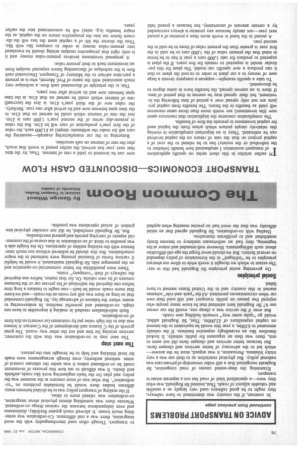The Common Roo
Page 78

If you've noticed an error in this article please click here to report it so we can fix it.
By George Wilmot MLecturer in Transport Studies, University of London
TRANSPORT ECONOMICS DISCOUNTED CASH FLOW
TN earlier articles in this short series on specific applications of transport economics I emphasized how benefit (whether to the individual or the society) has to be related to the cost of a capital project so that the rate of return on the capital involved can be estimated. There is an important complication in viewing this relatively simple picture which arises from the logical need for capital investment to precede the flow of benefits.
The complication concerns the implication that resources spent now (the investment) are worth more than those same resources will yield as benefits in the future. The benefits from capital projects are not only spread over a period of time following the investment, but their spread may be uneven in that period of time. If there is an uneven spread, the benefits have in some degree to be discounted.
To take a specific example—suppose a company invests a large sum of money in a car plant in order to re-tool the plant so that it can produce a new specific car model. The plant for this particular model is expected to remain for five years. If the plant is expected to produce for sale 1.000 cars a year it has to be borne in mind that the present value of the 1,000 cars to be sold in the first year is greater than the present value of those to be sold in the second year.
A pound in the hand is worth more than a promise of a pound next year—not simply because any promise is always surrounded by a certain amount of uncertainty, but because a pound held now can be invested to yield a rate of interest. Thus, by the time that next year has arrived, the earlier pound is worth that much. plus the rate of interest on safe securities.
Returning to the car manufacturing example—assuming the cars sell (to make the arithmetic simple) at 11,000 each, the value of the first year's production of cars will be £1m. But the value in present-day terms of the second year's 1.000 cars is £1m. less the rate of interest which could be earned on that flm. in the time span between now and its arrival after one year. Similarly, the value now of the third year's Lim. is less the (accrued) rate of interest which could be earned on that £1m. in the time span between now and its arrival after two years.
This is the principle of discounted cash flow, a technique very much associated with the name of Prof. Merrett, who is at present a part-time adviser to the Ministry of Transport. Discounted cash flow is the technique of discounting future expected receipts from an investment back to their present value.
A proposed investment involves present-value money and it is only right that prospective receipts arising should be translated into present-value money in order to compare like with like. Thus the shorter the life of a capital asset the less will the discount factor eat into the prospective return on the capital, as the major benefits (e.g. sales) will be concentrated into the earlier years.
























































































































